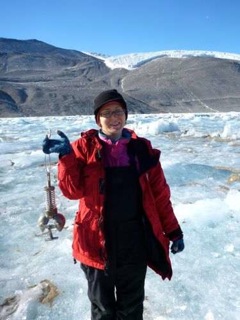Today was the first day where it felt like we're settled in and actually doing science. Megan's been working hard to get our lab tent organized, and we were able to drill our first hole through the ice, with the intention of taking samples and looking around, instead of just accessing drinking water.
I'll tell you all about drilling through the ice in a future journal -- it's a challenge, to say the least! Once we had the hole open, Tyler was able to get out his cameras, lower them into the open hole and document what the mats look like. We are hoping to find the mats that have a webbed, pinnacled shape, because they closely resemble shapes we find in the rock record from around 2.5 billion years ago. It was an exciting moment for all of us to see the footage from the GoPro camera -- we've expended considerable effort to reach this point! In this particular hole, the microbial community had a slightly different shape than what we were looking for, but now we know to drill the next hole a little closer to shore where the water is shallower.


We also will put a "grab sampler" down in the hole. It's got a bulb that clamps shut to capture microbes on the bottom of the lake. Megan will then take the samples collected to the lab tent, examine them under a microscope, and preserve them for further study back at U.C. Davis.

Overall, it was an exciting day to finally do some of the things we came here for!


Comments